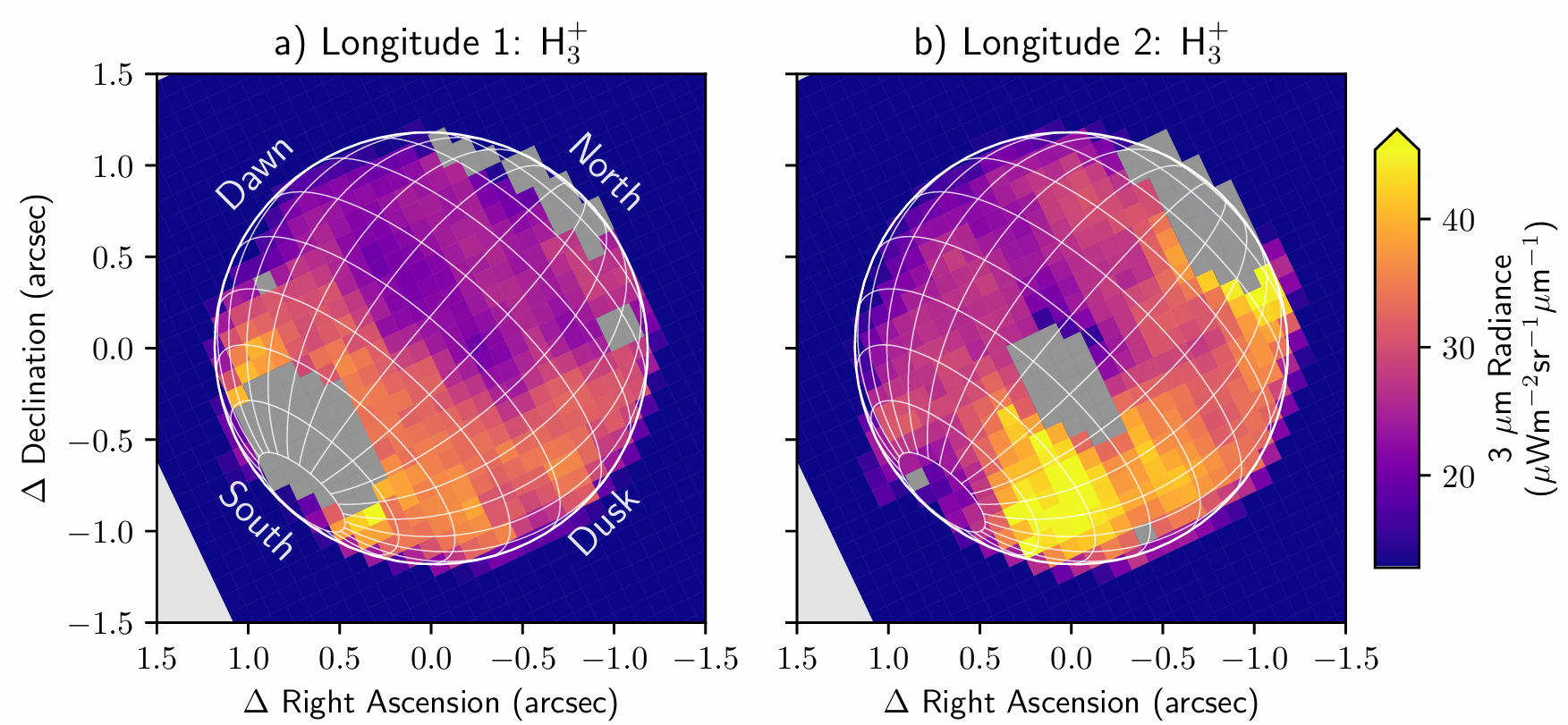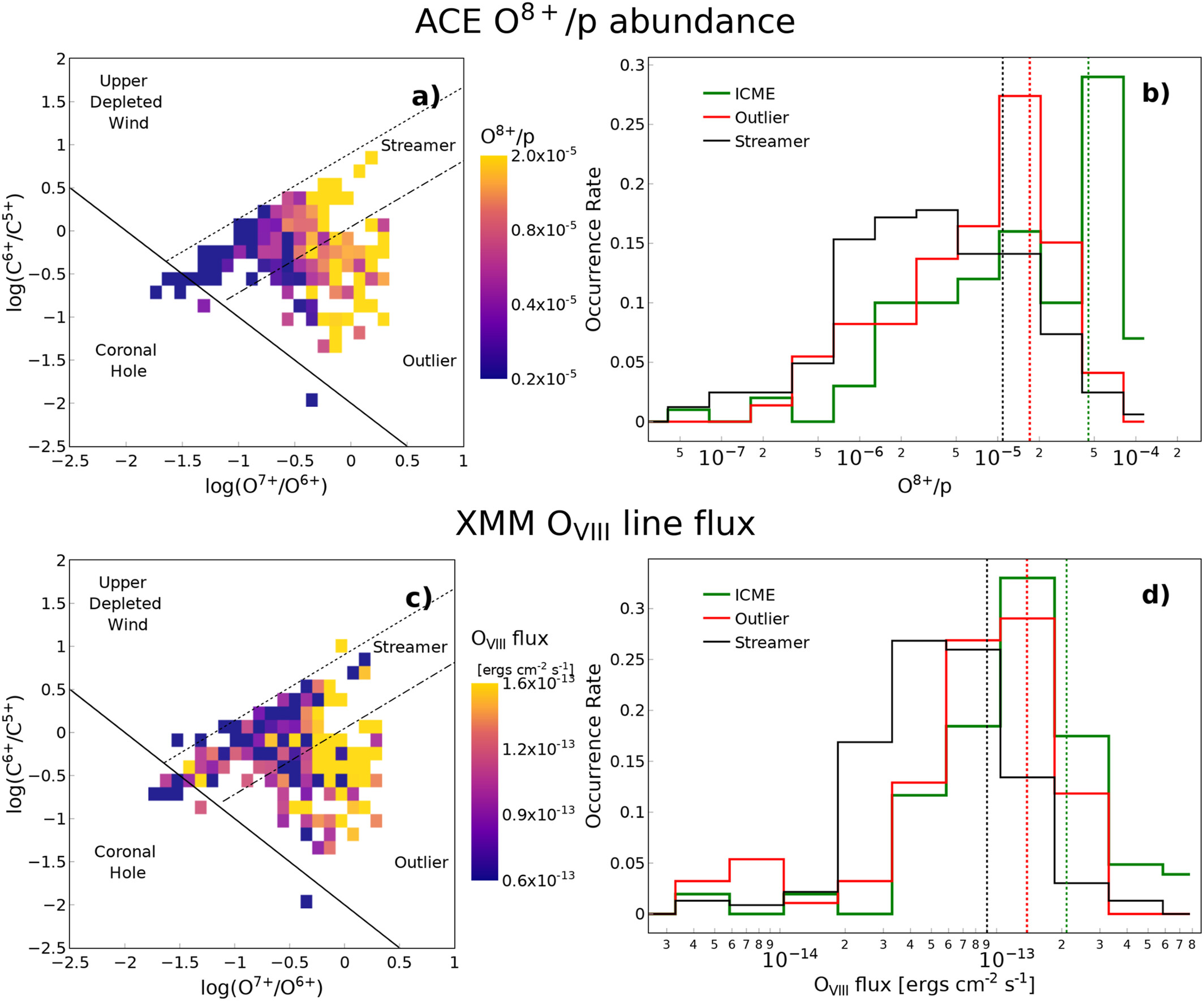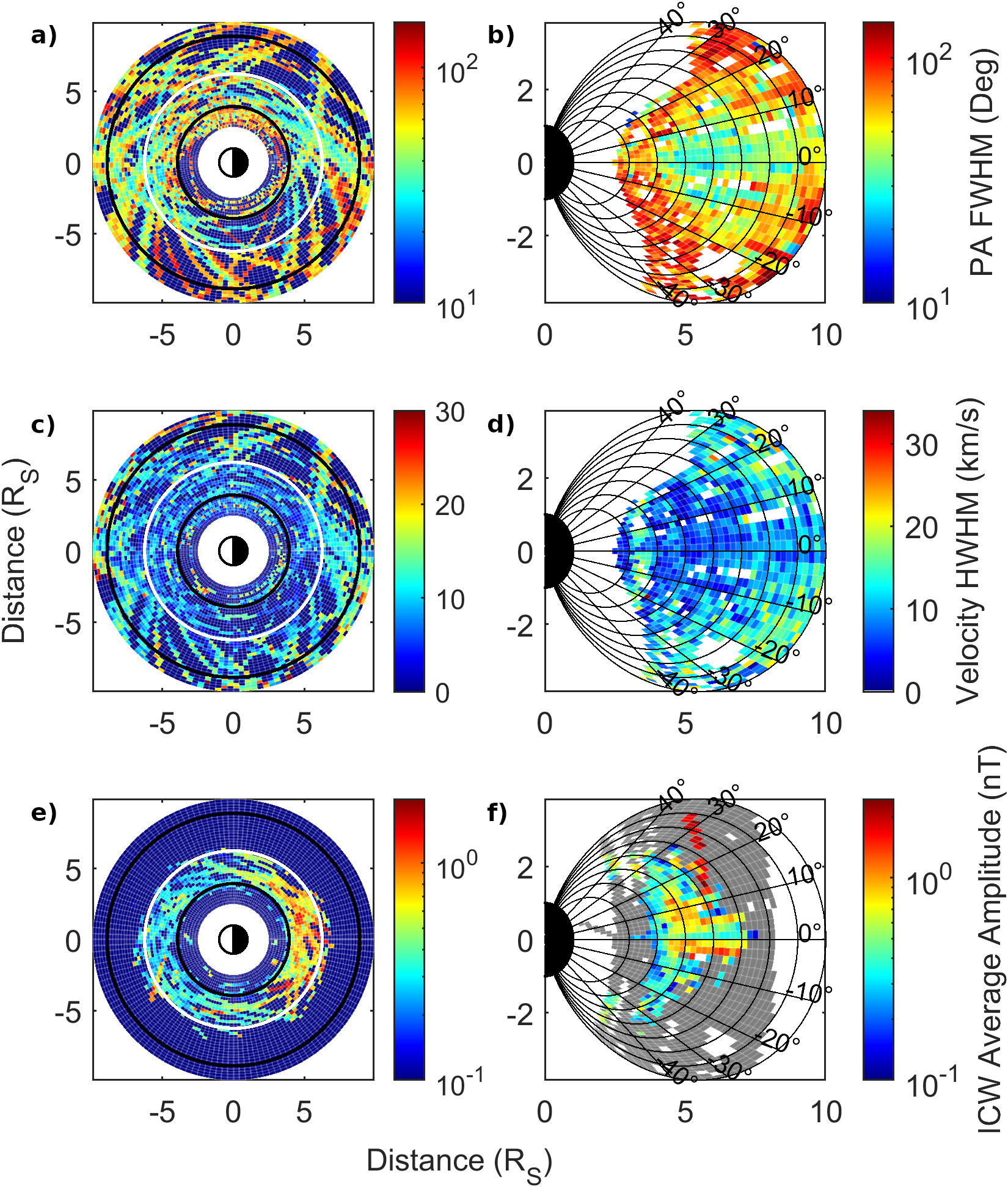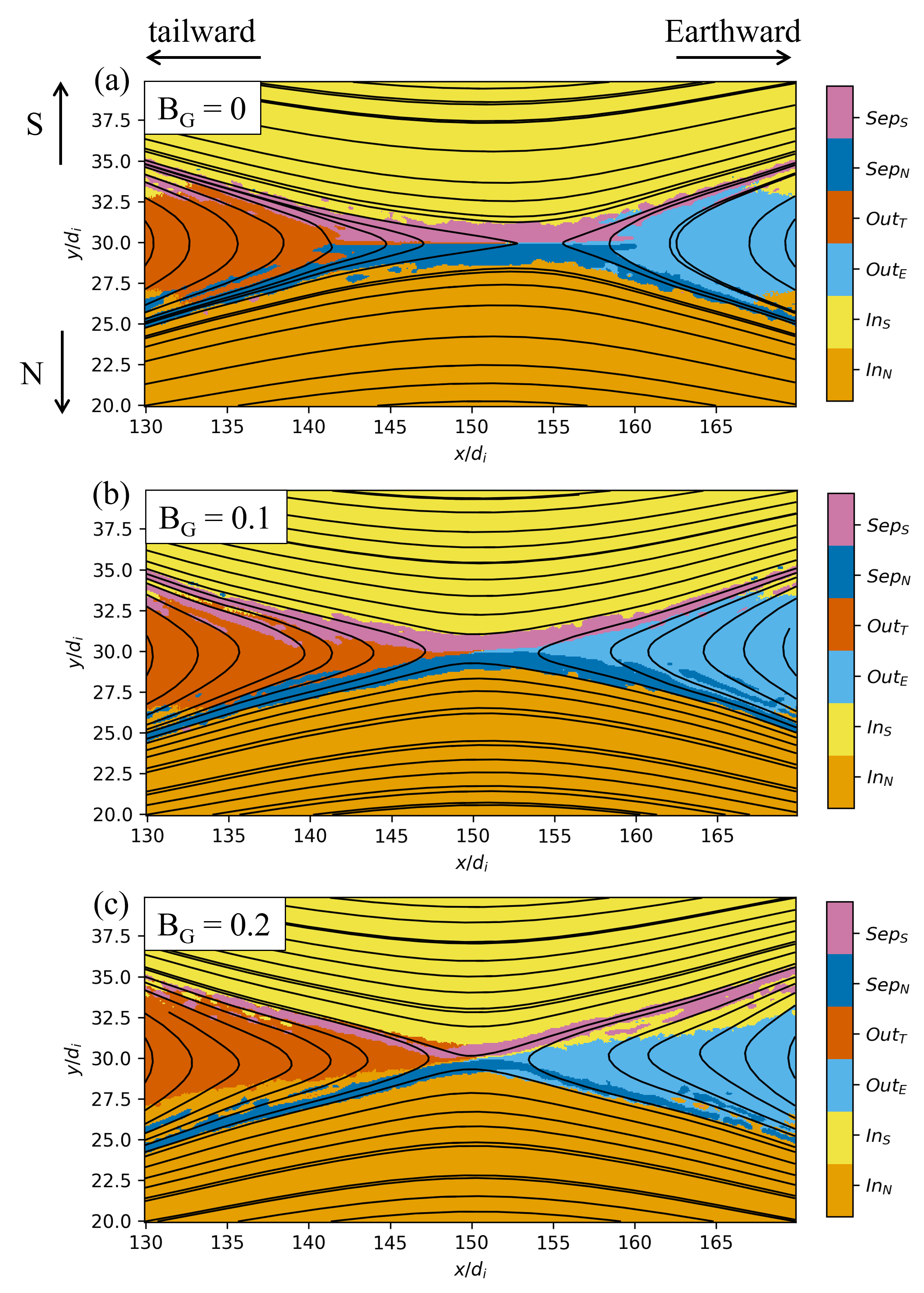MIST
Magnetosphere, Ionosphere and Solar-Terrestrial
Nuggets of MIST science, summarising recent papers from the UK MIST community in a bitesize format.
If you would like to submit a nugget, please fill in the following form: https://forms.gle/Pn3mL73kHLn4VEZ66 and we will arrange a slot for you in the schedule. Nuggets should be 100–300 words long and include a figure/animation. Please get in touch!
If you have any issues with the form, please contact This email address is being protected from spambots. You need JavaScript enabled to view it..
Discovery of H3+ and infrared aurora at Neptune with JWST
By Henrik Melin (Northumbria University)
The molecular ion H3+ is a significant component of the ionospheres of the giant planets. By observing the near-infrared emission from this ion we can remotely diagnose the physical conditions of this region. This layer of the atmosphere is an importance conduit for energy transfer between the space environment, magnetic field, and the atmosphere below, and it is in this region that magnetospheric auroral currents deposit energetic electrons that form enhanced temperatures and densities of H3+.
H3+ was discovered at Jupiter, Saturn, and Uranus over 30 years ago and a great number of studies have been able to characterise the processes that occur in the ionospheres of these planets. However, despite many attempts using telescopes on the ground, H3+ has never been observed from Neptune, in spite of models predicting it should be detectable, based on data from the 1989 Voyager 2 encounter.
The James Webb Space Telescope (JWST) is the most powerful telescope ever put into space, designed to observe the first galaxies formed in the early Universe. We can leverage this extraordinary sensitivity to explore our own cosmic backyard, by pointing the telescope at the giant planets. The first JWST observations of Neptune were taken in June 2023, and we were able to detect H3+ for the first time (yay!), as well as localised H3+ emissions about the magnetic pole. In other words, we were able to detect the ionosphere and aurora of Neptune for the first time, exactly 100 years after it was discovered at the Earth (Appleton & Barnett, 1925).

See publication for details:
Melin et al., (2025), Nat. Astro., doi: https://doi.org/10.1038/s41550-025-02507-9
Can XMM-Newton Be Used to Track Compositional Changes in the Solar Wind?
By Simona Nitti (University of Leicester)
Continuous monitoring of the solar wind ion composition is vital for understanding solar-terrestrial interactions, particularly through the study of Solar Wind Charge Exchange (SWCX) emission. SWCX produces soft X-rays (<2 keV) when highly charged solar wind ions (e.g., O7+, O8+, C6+) interact with neutral atoms. This emission is ubiquitous across the solar system, occurring wherever the solar wind encounters interstellar neutrals or interacts with planetary environments, including those of Earth, Mars, Venus, Jupiter, and Pluto.
In this study (https://doi.org/10.1029/2024JA033323), we investigated whether SWCX emission from Earth’s exosphere, observed by the XMM-Newton telescope, can be used to infer solar wind composition. By comparing spectral line intensities extracted from XMM data with ion abundance measurements from the ACE spacecraft at L1, we found that OVIII emission closely tracks O8+ abundances. In contrast, other ions involved in the SWCX process—such as O7+, C6+, C5+, and Mg11+—do not exhibit a consistent correlation between their abundance and X-ray emission.
To explore whether XMM data still encodes information about the solar wind state, we employed a Random Forest Classifier to predict solar wind types, following the classification scheme by Koutroumpa (2024). Incorporating XMM features alongside proton parameters significantly improved model performance, with a macro-averaged F1 score of 0.80 ± 0.06, compared to 0.55 when using proton data alone. Notably, XMM emission features ranked among the top five most important inputs. Moreover, XMM emission features ranked among the top five most important predictors. This suggests that, while individual ion abundances cannot currently be inferred directly from emission fluxes, XMM still provides valuable insight into the solar wind type, from which an average compositional profile may be inferred. This work is particularly timely given the degradation of the heavy ion spectrometer onboard the Advanced Composition Explorer (ACE), which has left the scientific community without reliable near-Earth ion composition measurements since 2011.
 (a) SWCX periods ACE O8+/p (where p is proton density) 2D histograms, averaged over their occurrence between 2000 and 2009, in a (O7+/O6+)×(C6+/C5+) space, with black lines separating different solar wind types.
(a) SWCX periods ACE O8+/p (where p is proton density) 2D histograms, averaged over their occurrence between 2000 and 2009, in a (O7+/O6+)×(C6+/C5+) space, with black lines separating different solar wind types.
(b). Occurrence rate of ACE O8+/p for the Streamer (black), Outlier (red) wind and ICMEs (green).
(c) (d) Same as left plots but for OVIII ion line fluxes from the XMM SWCX data set.
See publication for details:
, , , , , , & (2024). Can XMM-Newton be used to track compositional changes in the solar wind? Journal of Geophysical Research: Space Physics, 129, e2024JA033323. https://doi.org/10.1029/2024JA033323
Pick-up ion distributions in the inner and middle Saturnian Magnetosphere
By Cristian Radulescu (Mullard Space Science Laboratory, UCL)
Pick‐up ions (PUIs) are charged particles that have been accelerated by electric and magnetic fields beyond the speed of the bulk plasma and then proceed to thermalize through wave‐particle interactions. In this paper we investigate the distribution of PUIs in Saturn’s magnetosphere. We specifically look at water group PUIs as these are expected to be the most prevalent due to the majority of plasma in the inner to middle magnetosphere of Saturn coming from the moon Enceladus. Data from the Cassini spacecraft’s CAPS instrument is used, with the bulk plasma population and penetrating radiation subtracted, spanning radial distances from 3 to 10 Saturn radii (RS) and the time period between 2005 and 2012. Ten-minute intervals of this data are plotted on radial vperp vs vparallel plots. The width in pitch angle (PA) and velocity are measured and then distributed into 0.2 RS by 2° bins on global maps of the Saturnian magnetosphere. We find that the PUI distributions broaden with increasing latitude creating a “Pacman”-like signature. This pattern is approximately anti-correlated with the amplitude of ion cyclotron waves (ICWs). The explanation for this phenomenon lies in cyclotron resonance between the PUIs and ICWs. ICWs get driven/damped by the PUIs resulting in energy transfer between them and scattering of the PUIs in PA. The strongest resonance, and hence scattering, is expected in areas of high ICW amplitude, which is close to the equator. We find that this is not the case here because the PA scattering time is much longer than the PUI bounce period meaning ions reach high latitudes by the time they get scattered by the equatorial ICWs. In contrast, the half-widths of the velocity distributions remain mostly constant, increasing only past the orbit of Rhea, likely because of elevated plasma temperatures.

Global maps of the Saturn magnetosphere with top-down (left) and side (right) views. a)-b) show the PA distributions shown as the full width at half maximum (FWHM) of
the distribution at the injection velocity at the middle of the measured interval. c)-d) show the velocity distributions shown as half width at half maximum (HWHM) of the distribution. e)-f) show the average amplitude of ion cyclotron waves (reproduced from Long et al. (2022)). The grey bins in f) are bins where measurements were made, but no waves were detected. In the top down view, the inner black circle is the orbit of Enceladus, the white circle is the orbit of Dione and the outer black circle is the orbit of Rhea.
See publication for details:
Radulescu, C. R., Coates, A. J., Simon, S.,Verscharen, D., & Jones, G. H. (2025).Pick‐Up ion distributions in the inner andmiddle saturnian magnetosphere. Journalof Geophysical Research: Space Physics,130, e2024JA033390. https://doi.org/10.1029/2024JA033390
Classifying Magnetic Reconnection Regions Using k-Means Clustering: Applications to Energy Partition
By Cara Waters (Imperial College London)
Magnetic reconnection is a universal process which facilitates the repartition of magnetic energy to particle energies. It is important to understand the structure of reconnection regions and how they convert and partition energy. As visual identification of such structures can be subjective and time consuming, we take an unsupervised machine learning approach involving k-means clustering.
Carrying out this clustering on a 2.5-D particle-in-cell simulation of symmetric reconnection comparable to that in Earth’s magnetotail, we identify that the optimal number of clusters is six. We input only field and plasma variables to the clustering, giving a result which is independent of position. We identify two inflow regions, two outflow regions, and two pairs of separatrices. By looking at the distributions of the energy flux densities in these regions, we confirm that outgoing particle energy flux densities from reconnection decrease as guide field increases. The ion enthalpy flux density is the most dominant form of energy flux density in the outflows, agreeing with previous studies, and Poynting flux density may be dominant at some points in the outflows and is only half that of the Poynting flux density in the separatrices. This demonstrates an approach which may be applied to large volumes of data to determine statistically different regions within phenomena in simulations and could be extended to in situ observations, applicable to future multi-point missions.

Results of carrying out k-means clustering with six clusters on comparable simulation runs with (a) BG = 0, (b) BG = 0.1, and (c) BG = 0.2. Magnetic field lines are shown in black, with the colour showing the regions identified by the k-means clustering. These regions are labelled in relation to the equivalent directions in GSM coordinates in the case of magnetotail reconnection. Each simulation run has k-means carried out independently with variables scaled in the same manner and subsequent clusters re-numbered for comparison between each case.
See publication for details:
Cara L. Waters, Jonathan P. Eastwood, Naïs Fargette, David L. Newman, Martin V. Goldman. Classifying Magnetic Reconnection Regions Using k-Means Clustering: Applications to Energy Partition, JGR: Space Physics, 2024, 129, 10. https://doi.org/10.1029/2024JA033010
Release of the 14th Generation of the IGRF
By Ciaran Beggan (British Geological Survey)
The standard reference model for the Earth’s main magnetic field is known as the International Geomagnetic Reference Field (IGRF). Its primary purpose is to aid scientific research as well as general navigation.
The Earth’s main magnetic field is not static and it changes slowly over time as a result of the chaotic and unpredictable flow of liquid nickel-iron in the outer core. To account for the change (known as secular variation), the geomagnetic community produces an updated version of the IGRF every five years. The latest IGRF is the 14th update and was released in November 2024 to ensure the continuation from the 13th generation whose validity ended in January 2025.
The model consists of a series of snapshot Gauss coefficients every five years from 1900 to 2030. Gauss coefficients can be thought of as the weights assigned to spherical harmonic functions, the summation of which allows a compact and efficient method of determining the magnetic field anywhere on the globe, above or below the surface. The coefficients are defined to degree and order 13 in the latest generation, which gives an approximate spatial resolution of 3000km at the surface.
Analysis shows that the Earth’s magnetic field continues to drift westwards across most the globe and weaken. The South Atlantic Anomaly which has deepened by around 150 nanoTesla over five years and moved westward at around 20km/year. A second low point offshore of South Africa is forming. The magnetic dip pole in the northern hemisphere continues to move rapidly away from Canada toward Siberia at a rate of 35km/year. In contrast, the southern hemisphere pole velocity has remained below 10km/yr since the 1960s. Interestingly, in early to mid-2026, both poles should briefly have the same longitude (136°E).

Maps of the three components of the magnetic field at 2025. The panels illustrate the Declination angle (i.e. angle between true and magnetic North), the Inclination (or magnetic dip) and Total Field Intensity from IGRF-14.